I enjoy writing these articles for my readers, you guys. I don't accept payment for writing reviews, my opinion on products is my own, but if you find my recommendations helpful and you end up buying something through one of the links I may be able to receive a commission on that. More information
This week in question it a referee: a basketball backboard or loose basketball hoop? What's the best thing to buy?
Finding the right basketball hoop for your home can be tricky, because where does it fit? And do I have to buy a separate pole or do I attach one to the wall?
Oh, and do you use it both indoors and outdoors?
That's why I've devoted an entire article to it, so that you can make a conscious choice for your home game.
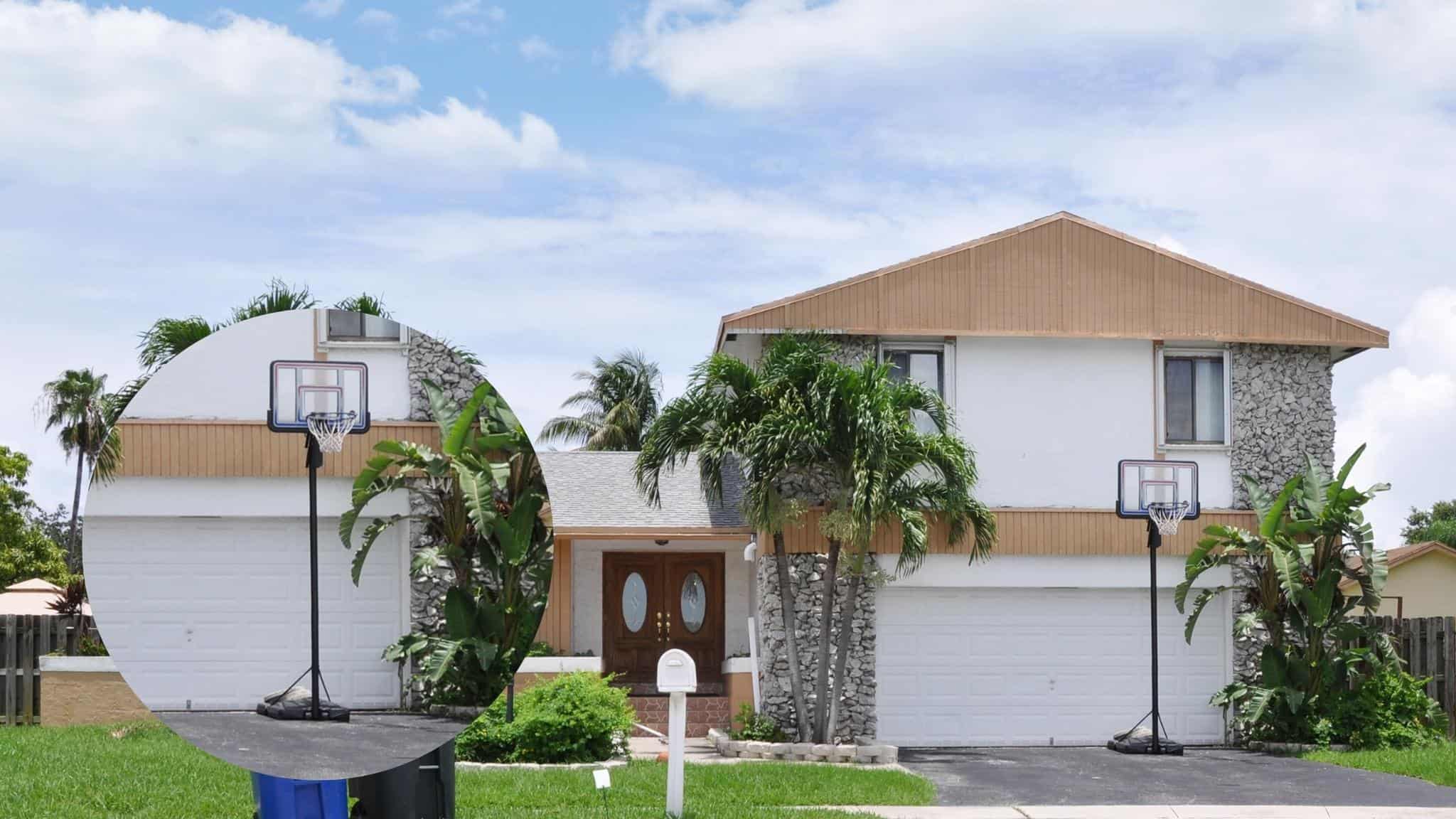
I give you all the information to make an informed choice when purchasing a sign or ring for your driveway or for the garden.
So I'll also talk about the different board types, rims, and other features to look out for.
My absolute best choice is this portable board from Lifetime. I would recommend a portable board myself because it lasts much longer than a board that you mount on the wall. Plus you can put it anywhere and clean it up again, on the wall you are usually limited to above the garage.
And Lifetime has some of the best value for money I've seen, more than enough options for almost any game of basketball.
First, let's get some inspiration in what your options are, and then I'll take you through everything a good board must meet:
| basketball board | Images |
|---|---|
| Best portable basketball backboard: Lifetime Streamline | 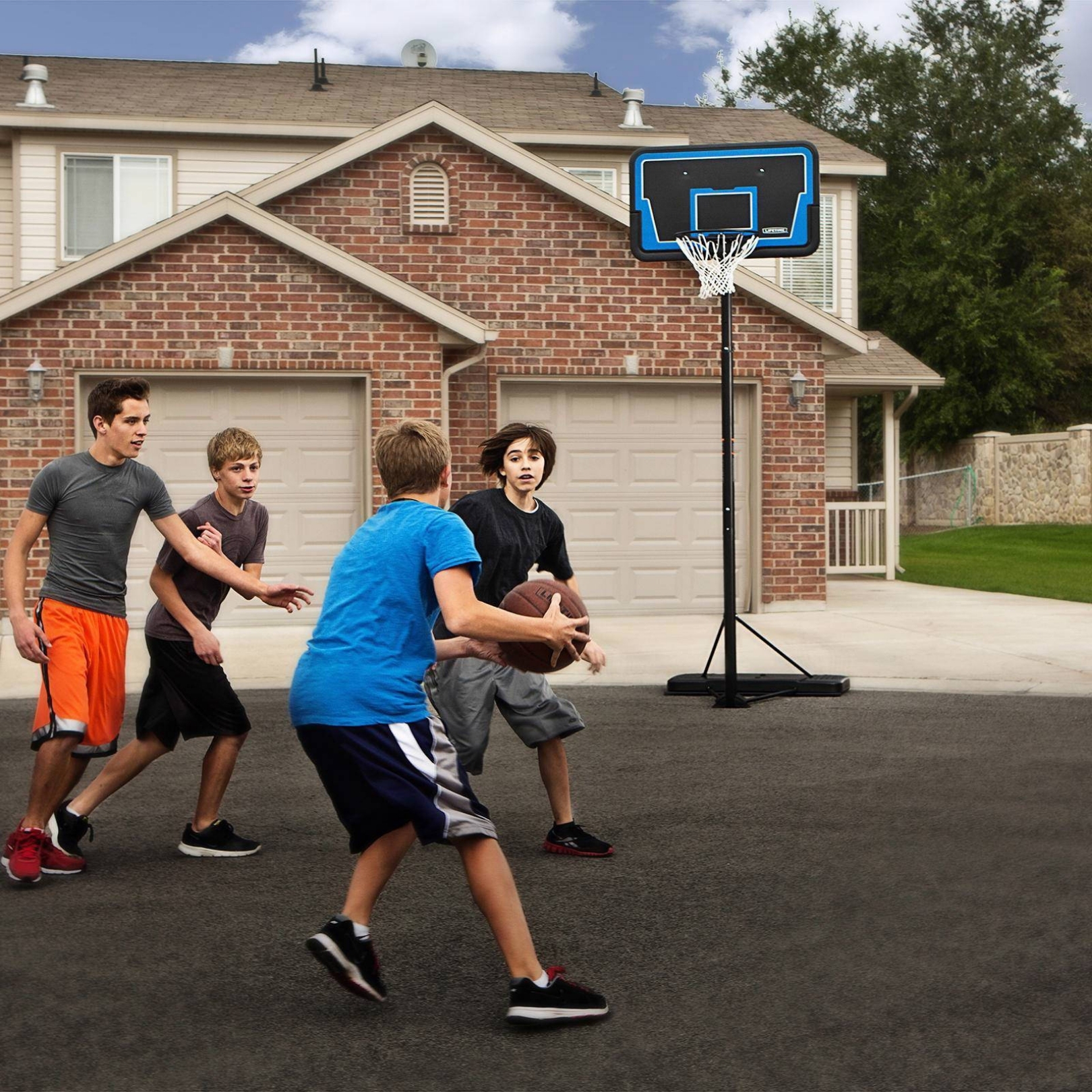
|
| Best inground basketball backboard: EXITGalaxy | 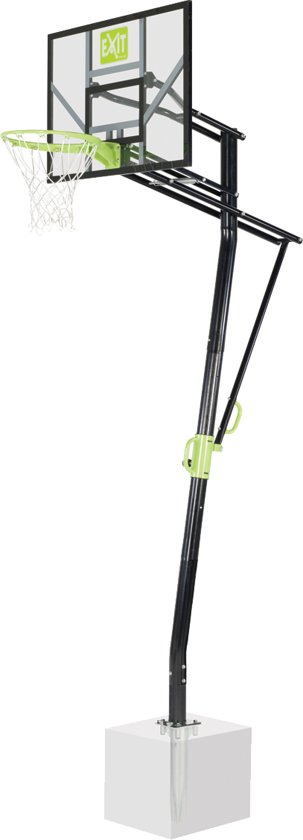
|
| Best Wall-Mount (or Wall-Mounted) Basketball Backboard: VidaXL | 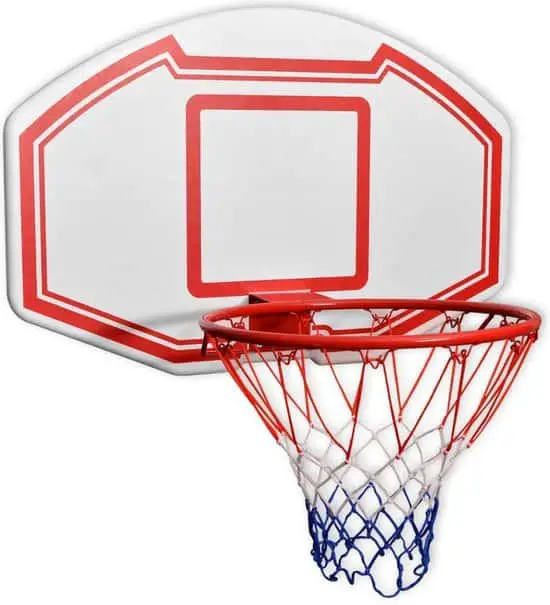
|
| Best basketball hoop for over the garage: KBT | 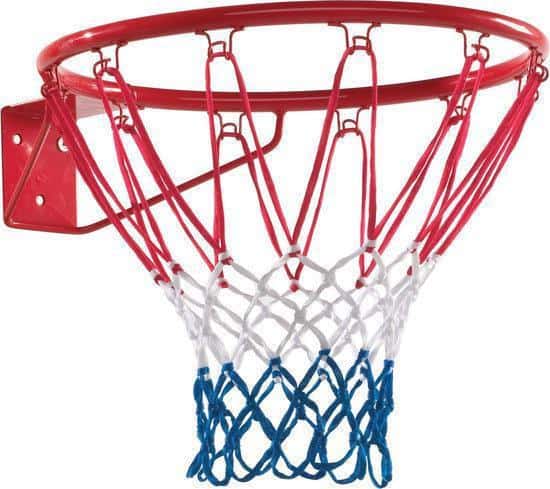
|
| Best Basketball Board for Bedroom Wall or Basement: Basketball Head | 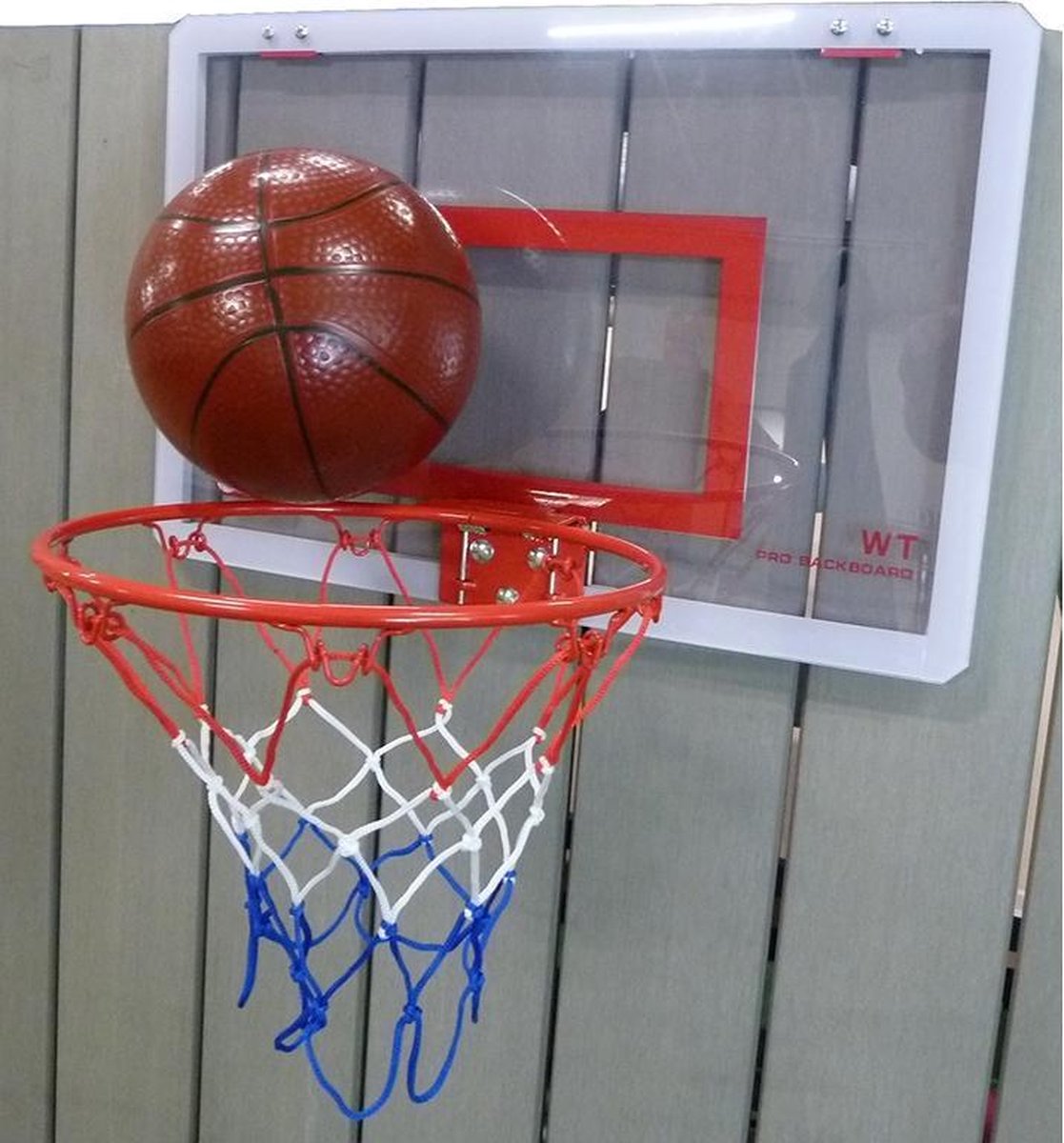
|
What we discuss in this comprehensive post:
Different Basketball Hoop Types
There are three main ring types you can buy for a good game of basketball. These three types are:
- portable
- fixed in the ground
- wall mounted
We'll break down each type now so you can better understand the pros and cons of each option.
Best Portable Basketball Board: Lifetime Streamline

Probably the most popular basketball hoop at the moment.
Portable basketball systems usually come with a base that can be filled with sand or liquid, which keeps the unit in place and stable.
These can vary enormously in size and capacity from 27 to 42 litres. Some larger hoops also have space to place rocks and other materials to help weigh down the basketball system.
Portable hoops are a good choice for most homes because they are easy to transport and easier to install than in the ground.
Also watch this video about the Lifetime portable systems:
The disadvantage of portable hoops is that, especially in the cheaper segment, they will shake and vibrate more than buried plates or loose rings on the wall.
And certainly the cheaper ones are not suitable for dunking.
One of the better systems for the price is Lifetime's. It is height-adjustable, so it can last a long time even with growing children and is durable, portable if you want to store it in the winter, but at the same time very sturdy.
- Height adjustable from 1,7 to 3,05 meters
Check the most current prices and availability here
Best Inground Basketball Board: EXIT Galaxy
In general, in-ground signs are significantly more stable than portable systems. This is because many of the support posts of these signs are set into the ground with concrete.
We recommend these basketball poles for serious players who want to take their game seriously and who have a stable living situation and are unlikely to move.
If you move often, a portable hoop is probably a better fit for your home.
It's important to note that because buried signs require you to set them in concrete, they can be significantly more difficult to install properly (and level).
I would opt for a portable board, such as the one from Lifestyle above, but if you have the space and want to make an inground basket, then you can't make a better choice with this EXIT Galaxy.
A big advantage of this EXIT over other backboards that you can dig in (there are many more brands that are also sturdy and won't fall over or break, some of the most important things about a basketball backboard), is that it is in height is adjustable.
This makes it a good investment from a younger age, because when you start digging it in you also want it to last with your kids for a while, or maybe you like to be able to dunk yourself now and then :)
With a handy slide system, the height is adjustable and you have a sturdy plate in the desired place within a few minutes.
You can't find better than the EXIT Galaxy!
EXIT Galaxy vs Lifetime Streamline Basketball Poles
I would like to briefly dwell on these first two options, because the choice is not only between buried or a mobile pole.
EXIT also has this Galaxy model that is mobileso you could also buy those:
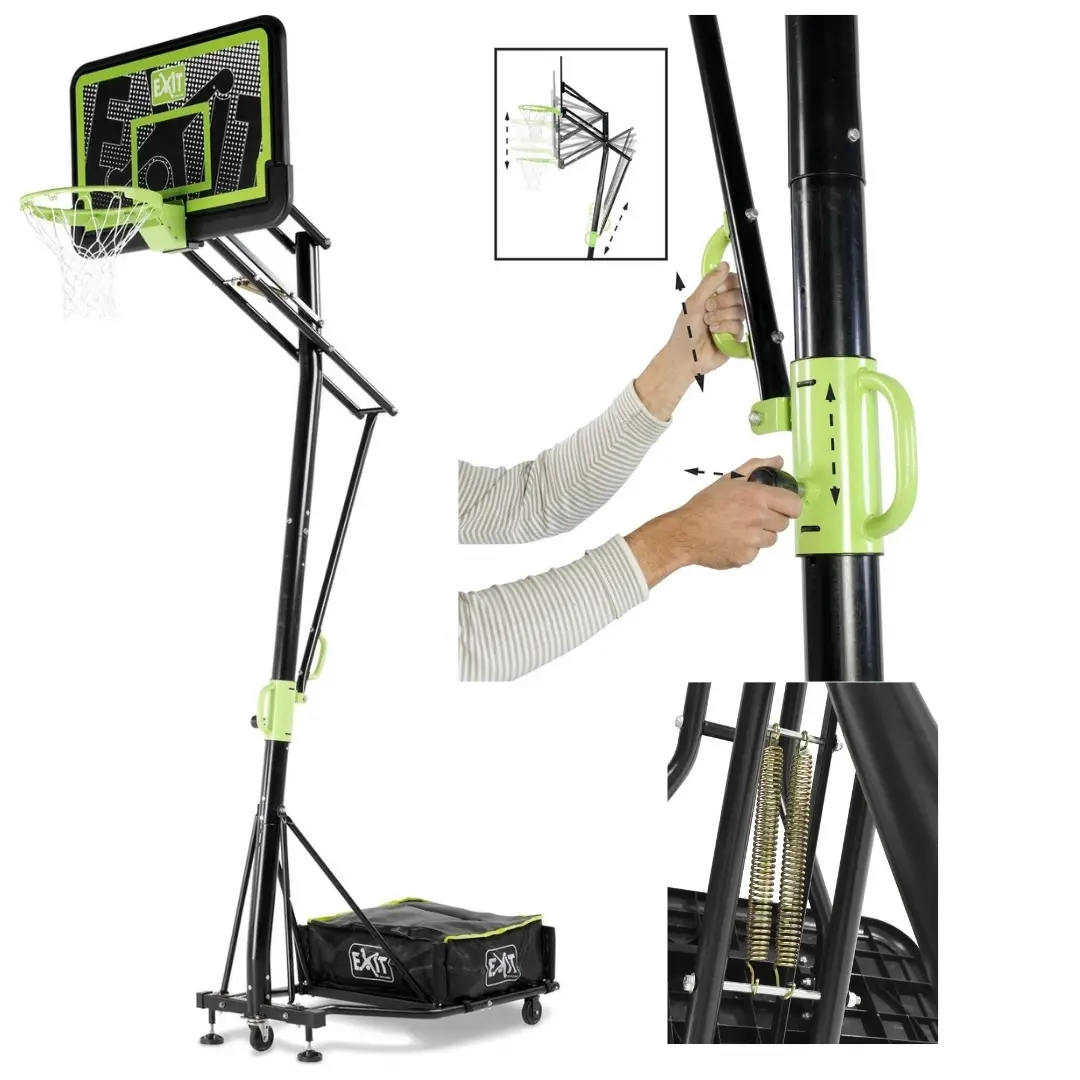
Still, in the standalone pole category, I chose Lifetime's not because it's the best on the market (I think EXIT comes close to that), but because for people who want to buy a standalone pole, they usually go for one that is cheaper.
And Lifetime has the best value for money I've seen. A lot cheaper than the Galaxy and with a lot less features, like the firm suspension you can see in the picture above, but enough for almost any level of player.
Here's this model from EXIT in their own video:
Best Wall-Mount (or Wall-Mounted) Basketball Backboard: VidaXL
Wall bracket rings have become less popular over time due to the convenience of the portable basketball hoop.
However, these are fairly stable units due to the support brackets used and because they are often attached to a building.
If you have a garage and driveway side by side, wall mounting systems are a good choice.
You also see them by far the most in a driveway.
You can still opt for one with a backboard here, or a really loose ring if you just want to throw it against the wall.
These are the best I've seen that will last on your wall for a while: the VidaXL basketball backboard:

Best Basketball Hoop for Over the Garage: KBT
If you really want to choose completely undressed, then there is the KBT basket ring with net but without backboard:
Best Basketball Board for Bedroom Wall or Basement: Basket Head

If you want a basketball backboard for indoors, for example your bedroom or maybe the basement, you should look for something smaller.
I would recommend not to go for the toy signs you attach to the door!
They really REALLY break and they keep falling off.
Get one that's a lot sturdier instead, and I can definitely recommend this Basket Head with metal ring.
That's how you can a bit of real basketball practice or even play a small game of basketball just indoors.
Of course, the Basket Head is suitable for indoor AND outdoor use, so even if you have a smaller backyard or not much space on the wall above your garage, it should work just fine.
Different rims
Probably the most important piece of the hoop's hardware is the rim that comes into play on almost every shot.
Almost all modern ring systems have some sort of breakaway mechanism that helps to release tension on the hoop when hit, minimizing the risk of breaking the board.
Three types of rims are found on recreational basketball hoops:
Standard Rim (no springs)
The standard rim that comes with recreational basketball hoops is the one without springs.
Standard rims have been around for decades and were used on all basketball hoops.
Since the inception of spring-loaded break-up rims, standard rims are not used as often anymore. Today, standard rims are mostly found on low-priced portable basketball hoops.
Because they don't have a release mechanism, standard rims tend to bend, warp and break, especially when used for dunking.
On the plus side, if you're just using them for layups and regular jump shots, they're pretty decent depending on the quality of the other components of the system.
Open Spring Breakaway Rim
Most modern basketball backboards on sale today have a spring-loaded, open rim where the springs are exposed.
There are usually one or two springs on these basketball hoops. The exposed springs can rust over time if you live in a humid climate like us.
The truth about these exposed feather rims is that their feathers are often of low quality. This often makes the hoops too bouncy when the basketball hits the rim when firing, which affects the performance of the hoop in general.
This makes it more difficult to score than it should be.
Not to mention that these rims will still wear out with dunking over time.
Closed Spring Breakaway Rim
Generally found on mid-tier and top-tier basketball rims, enclosed springbreak rims are the top shelf of basketball rims.
However, not all are created equal. An embedded spring edge on a $500 board will not have the same quality as a $1500+ board that you also anchor in the ground.
One will be "ok" while the other will perform like the hoops found in professional arenas.
This is usually due to the materials used, the spring quality and the design.
Springs on these hoops are enclosed in a metal sheath so they are not exposed to the elements, making them last longer.
Different types of basketball backboards
There are three main types of backboards to choose from and they include: polycarbonate, acrylic and tempered glass.
Polycarbonate Plates
Polycarbonate backs tend to be common on less expensive basketball hoops.
This is actually a kind of plastic that is rigid and can withstand the effects of the weather well.
On the other hand, the performance of polycarbonate on the backboards is often less than superb.
When using a polycarbonate backboard you will find that the ball doesn't come off the backboard with much force which can be attributed in part to a lack of brace support in cheaper hoops.
For someone just looking for a family recreational hoop, a polycarbonate backboard will probably fit your needs.
Acrylic plates
Thermoplastic acrylic backboards generally outperform their polycarbonate counterparts.
This is why many mid-range hoops come with an acrylic backboard, making acrylic a great choice for the majority of basketball system buyers.
The quality and durability is evident when playing on an acrylic board as the ball will fall off the board with more bounce.
Tempered Glass Plates
Finally, we have the mother of all board materials, which is tempered glass. While acrylic and polycarbonate are both forms of plastic, tempered glass is the real deal and used in gyms across the country.
Therefore, this type of board offers the most refined performance available.
Since tempered glass excels in board performance, it should come as no surprise that it is also the most expensive board material available.
This is suitable for advanced players who take their game very seriously and plan to spend many hours on their skills.
If you practice for hours and hours on a board that reacts very differently than it would in a game, you may be learning the wrong form.
The only drawback to tempered glass is that it is much less durable than polycarbonate and acrylic. This means that if your portable hoop tips over in bad weather or a dunk, the glass could shatter.
The dimensions of the board also vary and can come in two forms:
- fan
- or square
Most basketball hoops today have a square backboard that provides a larger area for missed shots during your game of basketball.
Square backboard in sizes from 42 inches to the regulation 72 inches.
Remember that larger boards are generally more expensive depending on the material.
Pro Tip: Make sure the ring you are interested in comes with a backboard liner as this will make the game safer for everyone!
What is the best material for a basketball backboard?
What is the best material for a basketball backboard background?
Basketball backboard backgrounds, called backboards, can be made of many types of materials.
The best building materials for your hoop background will depend on the intended use of your board, and there are different standards for professional and amateur courts.
Goal of the board
Backboards used for official games have different requirements than backboards used for home use.
Cost also becomes a factor as simple board material such as wood will be much cheaper than custom fiberglass.
Transparent backboards
Top basketball organizations, such as the NBA, NCAA, WNBA, need transparent backboards. This is because official games are usually televised or have a seat facing the track that would be obscured by an opaque board.
Transparent backboards are usually made of toughened glass or fiberglass. High school gyms and gyms may not use transparent boards based on their seating arrangement.
Transparency rules
The NBA outlines certain rules for transparent backboards. Specifically, the board should have a 2-inch-thick white outline of a rectangle in the center of the board, behind the ring. The dimensions of the rectangle should be 24 inches wide by 18 inches.
Opaque Backboards
Plain wood is an inexpensive choice for a non-transparent backboard. Plywood is relatively easy to cut, shape and machine itself to meet specifications.
Keep in mind that plywood is inexpensive, but it can be relatively thin when used as a single sheet.
You can increase the integrity of the board by doubling its thickness: simply attach a second piece of cut plywood to the same parameters.
Dimensioning and Measurements
When making a basketball backboard, keep in mind that accurate specifications are needed for both the backboard and rim dimensions.
Backboards are generally shaped as a rectangle 6 feet wide by 3,5 feet long. The rim should be 18 inches in diameter measured from the inner edge of the rim.
Official hoops are 10 feet high, measured from the bottom of the rim to the ground. Unofficial rims can be easily adapted to the needs of the playing field.
Backyard Backboard Materials
If you're building a backyard courtyard for outdoor play, suitable back panel options include plywood and acrylic.
Marine plywood is particularly durable, resistant to warping and weathering. If you're going the acrylic route, the best choices are heavy grades like Plexiglas or Lucite.
In most cases, buying a ready-made basket with backboard is the best option, as these are already available in very affordable price ranges today.
Basketball Pole Support: Design
Support posts are available in three different versions:
- three-piece
- two-part
- one piece
This means that a three piece support pole literally uses three different pieces of metal to form the support pole, while a two piece support pole uses two pieces and a one piece basketball pole is one piece.
The rule when it comes to support posts is that the fewer pieces a support post has, the more stable it will be. One-piece support posts are therefore only found in higher-end basketball backboards.
While two-piece support poles can be found in portable hoops and mid-range baskets. Three-piece support posts can be found on cheaper portable basketball systems.
Backboard support
Less expensive basketball hoop options usually have a brace that helps adjust the hoop height in the center of the system.
The best performing baskets have a thicker buttress and additional bracing that takes up most of the backboard surface area, enhancing stability to vibration.
Pro-tip: Look for basketball backboards with padding on the support post and powder coated to prevent rust.
Rim height adjustment
Almost all portable and ground-mounted boards today have some sort of height adjustment mechanism.
You used to need a broomstick to adjust the height of the hoops.
Most often, basketball systems today come with a handle or crank mechanism that facilitates height adjustment.
Some of the least expensive options available still use a telescoping system, where you can put a bolt through the support rod and set it in several steps.
The most common adjustment range for hoops is 7 and a half feet with the official regulation of 10 feet.
Still, there are some hoops with a wider reach than this. Check the specifications of the particular ring you are interested in to get an idea of the height adjustment range and the adjustment mechanism it contains.
How high is a basketball hoop?
Many of the basketball backboards on the market are set to American standards.
For junior high, high school, NCAA, WNBA, NBA, and FIBA, the rim exactly 10 feet, or 3 meters and 5 centimeters above the ground. The rims on each playing level are 18 inches in diameter.
Backboards are also the same size on each of these levels. A regular board is 6 feet wide and 42 inches (3,5 feet) long.
What is the distance from the 3-point line?
The 3-point spacing varies between different levels of play. The NBA 3-point line is 23,75 feet from the hoop, 22 feet in the corners.
The FIBA 3-point line is 22,15 feet from the hoop, 21,65 feet in the corners. The WNBA uses the same 3-point line as FIBA.
At the NCAA level, the 3-point line spacing is 20,75 feet, for both men and women. At the high school level, the 3-point line spacing is 19,75 feet, for both boys and girls.
Junior High uses the same 3-point line spacing as high school.
What is the distance from the free-throw line?
The distance from the free-throw line is measured from a point on the floor directly below the backboard.
At the junior high, high school, NCAA, WNBA, and NBA levels, the free-throw line is 15 feet from this point. At the FIBA level, the free-throw line is actually a little further – 15,09 feet from the point.
How big is the key?
The size of the key, which is also often referred to as “the paint”, differs per game level.
In the NBA, it is 16 feet wide. The same goes for the WNBA. In FIBA it is 16,08 feet wide. At the NCAA level, the key is 12 feet wide. Middle school and junior high school use the same key as the NCAA.
Another sport to install at home: what is the best table tennis table for your budget?

